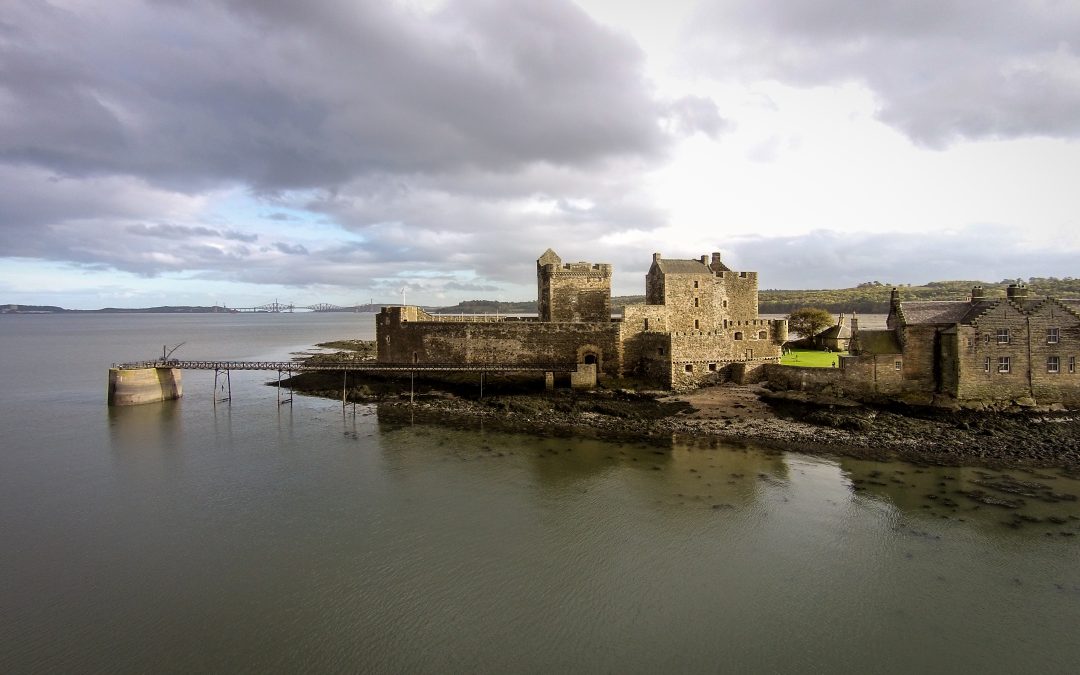The castle’s location on the shore of the Firth of Forth provides stunning views of the surrounding landscape. Visitors can explore the castle’s many rooms and corridors, including the Great Hall, the kitchen, and the prison cells. The castle’s architecture is a mix of styles, with elements of Gothic and Renaissance design. The castle’s walls are also adorned with intricate carvings and decorations, adding to its charm and beauty.
History of Blackness Castle
Blackness Castle is a historic fortress located in the Royal Burgh of Linlithgow, West Lothian, Scotland. The castle was built in the 15th century by Sir George Crichton, who was the Chancellor of Scotland during the reign of James II. The castle was built on a promontory overlooking the Firth of Forth, and it was strategically located to defend the port of Linlithgow and the surrounding area.
During the 16th century, Blackness Castle became a royal castle, and it was used as a prison for high-ranking prisoners. Mary Queen of Scots was one of the most famous prisoners to be held at Blackness Castle. She was imprisoned there in 1567, after she was forced to abdicate the throne in favour of her infant son James VI.
During the 18th century, Blackness Castle fell into disrepair, and it was used as a quarry for local builders. However, in the 19th century, the castle was restored, and it became a popular tourist attraction.
Today, Blackness Castle is managed by Historic Scotland, and it is open to the public. Visitors can explore the castle’s history and enjoy stunning views of the Firth of Forth. The castle has also been used as a filming location for several movies and TV shows, including Outlander and Mary Queen of Scots.
Architectural Features
Blackness Castle is a historical fortress located in West Lothian, Scotland. The castle is known for its unique architectural features that have been preserved over the years. The castle was originally built as an artillery fortress and later served as an armaments depot. Today, it is a popular tourist attraction that offers visitors a glimpse into the past.
The castle’s most prominent feature is its towers. The castle has four towers, each with its unique design and purpose. The main tower, also known as the Keep, is the tallest and most impressive tower. It served as the castle’s main residence and was used for defense purposes. The other towers served as lookout points and provided additional defense.
The castle’s artillery fortifications are another notable feature. The castle has several artillery fortifications that were used to protect the castle from enemy attacks. The fortifications include a curtain wall, which surrounds the castle and provides additional defense. The castle also has several ramparts that were used to mount cannons and other artillery.
Blackness Castle in Popular Culture
Blackness Castle has been featured in various popular culture works, including films, television shows, and novels. Its imposing structure and rich history make it an ideal location for period dramas and historical productions.
One of the most notable appearances of Blackness Castle in popular culture is in the hit TV series Outlander. The castle was used as a filming location for several episodes of the show, including the scenes featuring Jamie’s incarceration in the infamous ‘Wentworth Prison’. The castle’s eerie atmosphere and imposing walls made it the perfect setting for the show’s dark and dramatic scenes.
Blackness Castle has also been featured in several films, including the 1952 version of Ivanhoe and the 1998 film Elizabeth. In Ivanhoe, the castle was used as a stand-in for a Norman castle, while in Elizabeth, it served as a backdrop for the dramatic confrontation between Elizabeth I and Mary, Queen of Scots.
In addition to its appearances in film and television, Blackness Castle has also been featured in several novels, including the historical novel The Queen’s Lover by Francine du Plessix Gray. The castle’s rich history and imposing presence make it a popular setting for historical fiction writers.
Visitor Guide
Tickets and Entry
Entry to Blackness Castle requires a ticket, which can be purchased online or at the site. The castle is open daily from 9:30 am to 5:30 pm, with last entry at 5 pm. Visitors are advised to book tickets online to guarantee entry, especially during peak season.
Facilities
Blackness Castle has a small shop selling souvenirs, books, and refreshments. The castle also has a car park with free parking for visitors.
Accommodation and Tours
There is no accommodation on site, but visitors can find a range of options in nearby towns such as Falkirk and Edinburgh. Guided tours of the castle are available, and visitors can also explore the castle at their own pace using an audio guide.
Things to Do
News and Weather
Visitors can stay up to date with the latest news and events at Blackness Castle by checking the official website or following the castle’s social media accounts. The weather in West Lothian can be unpredictable, so visitors are advised to dress appropriately and check the forecast before setting out.
Membership and Admission
Blackness Castle is a popular tourist attraction located in West Lothian, Scotland. The castle offers a variety of admission options to cater to different visitors’ needs.
Admission Prices
The admission prices for Blackness Castle are as follows:
| Admission Type | Price |
|---|---|
| Adult | £6.00 |
| Concession | £4.80 |
| Child (under 5) | Free |
| Young Scot Card Holder | Free |
Membership
Membership to Blackness Castle is available through Historic Environment Scotland. Members enjoy free entry to over 70 historic sites across Scotland, including Blackness Castle. Membership options include:
- Adult Membership: £49 per year
- Joint Adult Membership: £79 per year
- Concession Membership: £39 per year
- Family Membership: £79 per year
Join Now
To become a member of Historic Environment Scotland and gain free entry to Blackness Castle and other historic sites, you can join online or in person at the castle.
English Heritage and Cadw Members
English Heritage and Cadw members can enjoy free entry to Blackness Castle upon presentation of a valid membership card.
Visitors are advised to check the Blackness Castle website for up-to-date admission prices and opening times before visiting.
Location and Transport
Blackness Castle is located in the town of Blackness, West Lothian, Scotland. It stands on the southern shore of the Firth of Forth, approximately 10 miles west of Edinburgh and 5 miles east of Linlithgow. The castle is easily accessible by car, train, and bus, making it a popular tourist destination.
By car, visitors can reach Blackness Castle via the A904 road from Linlithgow or Bo’ness. There is a car park located near the castle, which is free of charge. From the car park, visitors can walk to the castle in just a few minutes.
For those travelling by train, the nearest station is Linlithgow, which is approximately 3 miles away from Blackness Castle. From the station, visitors can take a taxi or bus to the castle. The bus ride takes approximately 15 minutes.
There are also several bus routes that stop near Blackness Castle, including the 49 and X49 services from Edinburgh to Linlithgow. The castle is approximately a 15-minute walk from the bus stop.
Visitors to Blackness Castle can also combine their trip with visits to other nearby attractions, such as Edinburgh Castle, Linlithgow Palace, and Hopetoun House. The castle is also situated on the banks of the River Forth, providing visitors with stunning views of the surrounding landscape.
Contact Information
You can contact us them through the following channels:
- Phone: +44 (0) 1506 834807
- Email: blacknesscastle@hes.scot
- Address: Blackness Castle, Blackness, Linlithgow, West Lothian, EH49 7NH
Hrs:
- Monday to Friday: 9am – 5pm
- Saturday and Sunday: 10am – 4pm
Additional Information
Blackness Castle in West Lothian is a fascinating historic site with a lot of interesting facts and information. Here are some additional details that may be of interest to visitors:
- Family-friendly: Blackness Castle is a great place to visit with children. There is plenty of space to run around and explore, and the castle’s history is sure to capture their imagination.
- Prison history: The castle was used as a state prison in the 17th century, and many prisoners were held there during this time.
- Membership: Visitors can become members of Historic Scotland, which offers exclusive access to a range of historic sites across Scotland, including Blackness Castle.
- Livingston: The nearby town of Livingston is a great place to stay while visiting Blackness Castle. It has a range of accommodation options, restaurants, and shops.
- Pet-friendly: Dogs are welcome at Blackness Castle, as long as they are kept on a leash.
- Biking: The area around the castle is great for cycling, with a number of scenic routes to explore.
- Attractions: There are a number of other attractions in the area, including the Linlithgow Palace and the Hopetoun House.
- Tour guide: Visitors can take a guided tour of the castle, which provides fascinating insights into its history and architecture.

